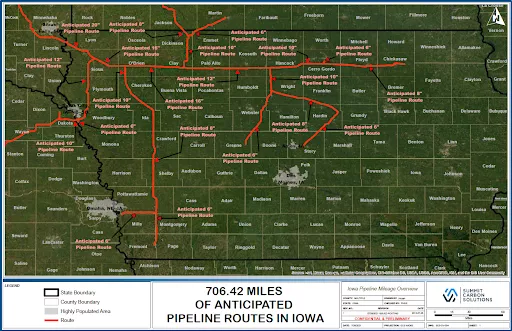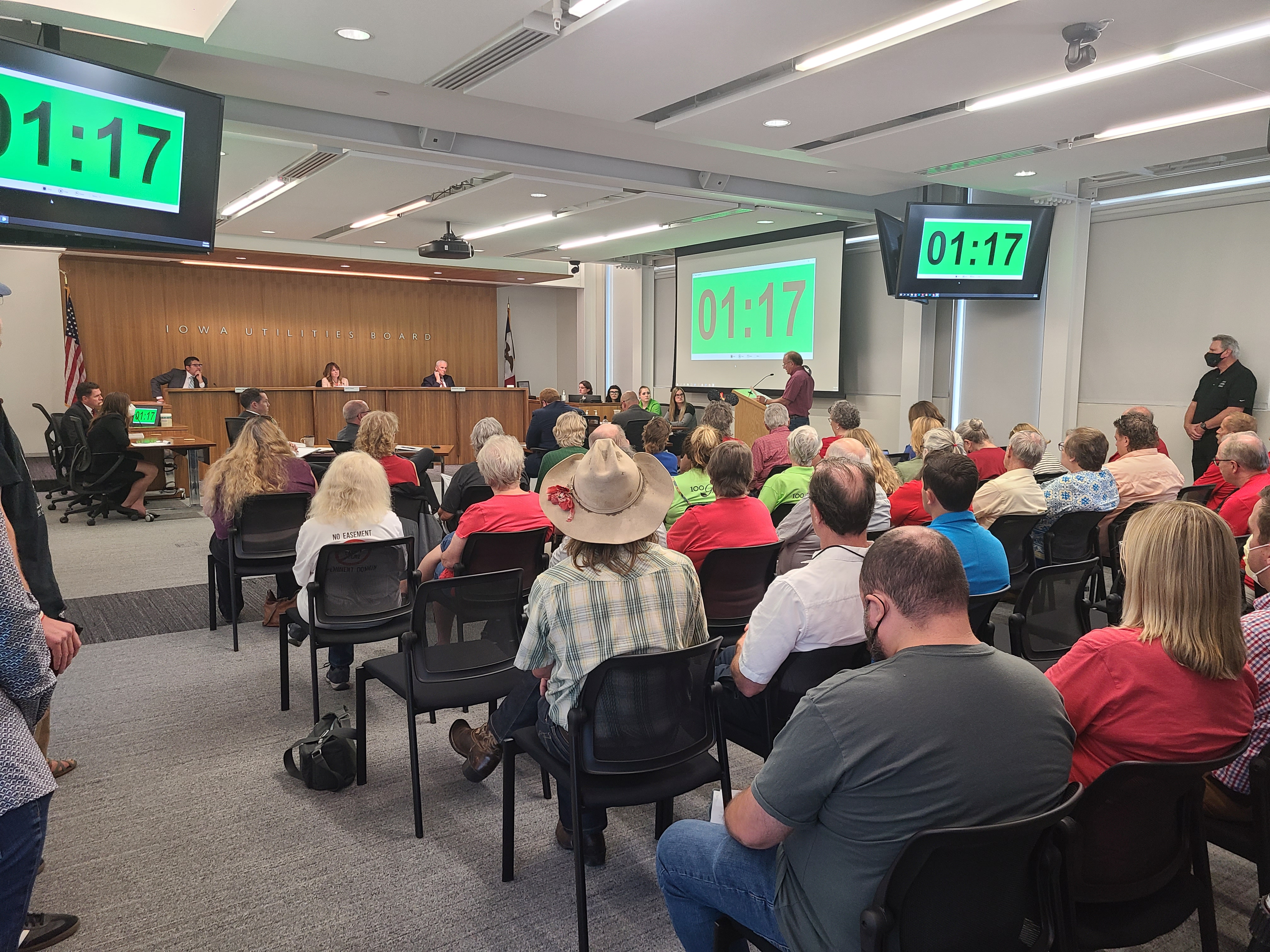"Iowa, America, and the world have never needed the Sierra Club as much as we do now."
Mike Tramontina, Executive Committee Member and Past Chair
What you can do to help the environment
-
Contact your state representative and state senator and let them know that you want them to protect landowners by banning the use of eminent domain for hazardous liquid pipelines.
-
Donate to the Iowa Chapter of the Sierra Club so that we can continue our work.
-
Catch up on this month's lunch and learn education videos
In this issue of the Iowa Sierran
Water Quality and Agriculture
-
Camanche water systems to be upgraded due to PFAS
Climate Change and Coal plants
-
Sierra Club Files Updated MidAm Coal Fleet Analysis in Wind PRIME
Carbon Dioxide Pipelines
Plus
-
Book discussion "Mini Forest Revolution" by Hannah Lewis
-
Join us for interesting and informative webinars and Lunch and Learns
-
Contribute to the Iowa Chapter
-
Volunteer for the Iowa Chapter
-
Calendar of events
-
To see the archive of previous Iowa Chapter newsletters
-
To see the White Pine Needle newsletter
Update on Supreme Beef
It has been a while since we last gave you an update on the Bloody Run Creek trout stream in northeast Iowa. Some interesting things have been happening.
Iowa’s Department of Natural Resources (DNR) gave a permit to Supreme Beef to house 11,600 cattle in several buildings at the head of the trout stream. When Sierra Club activists looked at the permit, it became obvious that there were serious flaws in the calculations for the nutrient management plan, which lays out the fields where the manure is going to be spread, application rates, and the nutrient content of the manure. Although, we protested, the DNR granted the permit.
As you can imagine 11,600 cattle excrete a lot of manure – 30 million gallons of it in a year. That requires a lot of farm land to dispose of the waste, which is used as a fertilizer. Excess fertilizer runs off the fields and into streams. We believe that the permit allows too much manure to be spread on the fields.
Making matters worse, the area is filled with sinkholes and karst formation. Karst bedrock has lots of cracks which allow the manure laden runoff to move into groundwater.
All of this creates a huge risk of allowing the manure to contaminate Bloody Run Creek trout stream, destroying the clean water trout need in order to survive. So, Sierra Club filed a lawsuit in Polk County district court.
One of the first things Sierra Club did was to request that we be allowed to take depositions of the Department of Natural Resources staff, of the person who wrote the permit application and the nutrient management plan, and an owner of Supreme Beef. Although the DNR tried to stop the depositions, the judge allowed Sierra Club to take them. The owner of Supreme Beef refused to have his deposition taken and that required a separate trip to court. Ultimately, he was forced to sit for a deposition.

Through the depositions, we discovered that the Department of Natural Resources does not verify that the data on the nutrient management plan is correct. The DNR staff admitted that they only look to see that the boxes on the nutrient management plan are filled in. The staff assume that the person writing and assembling the materials for the nutrient management plan is doing things correctly.
The Sierra Club was aware that the author of the nutrient management plan incorrectly calculated items and put invalid numbers on the application. When the deposition was taken of the author of the nutrient management plan, she admitted that she had written the nutrient management plan like this for several other permit applications. Nobody from the DNR told her she was doing things incorrectly.
Further, the author of the nutrient management plan and the owner of Supreme Beef pointed fingers at each other, blaming the other person for providing invalid data for the permit application and the nutrient management plan.
So, Sierra Club filed a 45-page brief which lays out the issues with the permit and asks the court to invalidate Supreme Beef’s permit. The Sierra Club also filed a 435-page appendix of documents we relied on and deposition transcripts.
The Department of Natural Resources and Supreme Beef have about a month to answer the issues in Sierra Club’s brief. By the end of December, Sierra Club gets an additional opportunity to reply. That will be followed by oral arguments on January 20, 2023.
We are hopeful that the judge will rule in our favor.
Camanche water systems to be upgraded due to PFAS
The Environmental Protection Agency recently settled with 3M, a major source of the PFAS contamination in the Mississippi River. PFAS is a class of toxic chemicals called perfluoroalkyl and polyfluoroalkyl substances. PFAS persists in the environment, does not break down, and is difficult to dispose of. The compounds are linked to cancer, liver damage, and abnormal childhood development.
3M had been discharging PFAS chemicals as far back as the 1970's. [4]
As part of the settlement, 3M is required to offer treatment to the Camanche Water Supply in Camanche, Iowa. [3, 4] That will mean either a new drinking water source or a new water treatment system. [5] Camanche is in eastern Iowa, near Clinton.
Two of the wells operated by the city of Camanche are contaminated. The third well is not contaminated, but cannot provide the quantity of finished water that the city needs. [5] According to Jared Strong's reporting, 3M and the city are considering drilling two more deep wells to replace the more shallow contaminated wells and are also discussing installing a treatment system to remove the PFAS chemicals from the water. [5]
The source of the PFAS was 3M's manufacturing plant near Cordova, Illinois. The PFAS entered the ground water through several means. It was emitted into the air. PFAS was flushed into the wastewater treatment plant where it was not removed from the water being discharged into the Mississippi River. PFAS was also a component in sewage sludge which was applied to land as a fertilizer; where stormwater was able to wash it into the Mississippi River. [5]
Sources
[1] Jared Strong, "Iowa drinking water from Mississippi River has 'forever chemicals", Iowa Capital Dispatch, February 25, 2022
[2] Jared Strong, "Iowa drinking water from Mississippi River has 'forever chemicals", Iowa Capital Dispatch, February 25, 2022
[3] Cloe Johnson, "3M to test, treat water supplies in Illinois, Iowa", Cedar Rapids Gazette, November 8, 2022
[4] EPA Press Office, "3M Agrees to EPA Order to Sample and Provide Treatment for PFAS Contamination in Drinking Water near Cordova, IL Facility", November 3, 2022
[5] Jared Strong, "Camanche in talks with 3M to fix 'forever chemical' contamination", Iowa Capital Dispatch, November 16, 2022
[6] Bennet Goldstein and Juanpablo Ramirez-Franco, "River towns seek answers about 'forever chemicals'", Cedar Rapids Gazette, November 20, 2022
Photo below, Wanatee Park in Linn County, Iowa, by Pam Mackey Taylor

Sierra Club Files Updated MidAm Coal Fleet Analysis in Wind PRIME
On November 22, the Sierra Club, Environmental Law and Policy Center, and Iowa Environmental Council filed joint testimony in MidAmerican’s Wind PRIME docket before the Iowa Utilities Board. MidAmerican’s Wind PRIME project, which would add 2,042 MW of wind and 50 MW of solar, relies on the company’s plans to continue operating 5 large coal-burning power plants in Iowa. These coal plants make MidAmerican the single largest carbon polluter in the state.
The testimony includes independent technical modeling analysis of MidAmerican’s generating fleet performed by Synapse Energy Economics and Energy Futures Group on behalf of the environmental groups. This analysis shows a balanced, reliable portfolio that adds a mix of battery storage, solar, and some wind while retiring all of MidAmerican’s Iowa coal plants by 2035 and delivers $120 million in cost savings relative to MidAmericans’s current plan, which focuses almost exclusively on new wind resources and continued coal burning. The alternative portfolio would also provide more around-the-clock clean energy than MidAmerican’s proposed Wind PRIME portfolio. Replacing coal plants with cost-effective, clean generation and complementary storage alternatives avoids substantial operation and maintenance costs and the additional capital investments that would be required to maintain MidAmerican’s aging coal fleet. In total, this plan would save 25 million tons of carbon compared to MidAmerican’s plan, the equivalent of taking more than 5 million cars off the road (more than all the cars in Iowa).
Resource diversity is critical to a reliable system going forward and a key difference between the Synapse/EFG modeling findings and MidAmerican’s plan to run a wind-coal system. “Diversified clean energy, coupled with storage and a robust transmission system, can provide all of our energy needs in Iowa and at a lower cost,” said Kerri Johannsen, Energy Program Director with the Iowa Environmental Council. “The status quo has led to escalating uncertainty around extreme weather, high fuel costs, and fears of energy shortages. This is not an acceptable future. MidAmerican must plan and invest now in a truly 100% clean system that works reliably and cost-effectively for Iowans. To ensure this transition delivers reliable and affordable electricity, MidAmerican needs to take steps now to study upgrades to the transmission system and to start development of adequate battery storage and solar.”
MidAmerican did not use any quantitative modeling to choose the Wind PRIME mix, but instead selected a resource mix based on the goals of maximizing energy market revenues and federal tax credits. Devi Glick of Synapse stated in her testimony that this approach “might be reasonable for a merchant utility, but it is not a reasonable approach for a rate-regulated utility with captive ratepayers.” Ms. Glick continued, “MidAmerican cites customers’ desire for affordable and reliable carbon free electricity to support the Wind PRIME project. But by assessing the project’s value based on energy generation and production tax credit revenues, MidAmerican is not positioning the utility to create a reliable, carbon-free electricity system. The Company is creating a wind-heavy energy system that is dependent on coal for meeting capacity needs, rather than integrating more solar and battery storage resources that exhibit complementary output patterns.” She adds, “Approving Wind PRIME as-is creates a wind-coal system that does not provide 100 percent clean energy and instead keeps five coal units running for 20 years or more, despite their advanced age, high costs, poor suitability for a high-renewable grid, and the presence of cheaper alternatives.”
The new analysis conducted by Synapse and Energy Futures Groups used utility industry best practices to assess whether the Wind PRIME project is the right set of resource additions to help the utility transition away from its heavy reliance on expensive and polluting coal combustion. The experts used a proven modeling platform that has been adopted in 17 states to identify reliable low cost electricity portfolios. The analysis found that three of MidAmerican’s coal plants -- Louisa, Neal 3, and Ottumwa -- are uneconomic and should be retired as soon as feasible. The plan additionally includes retiring the remainder of the coal plants by 2035 and leverages the benefits of the Inflation Reduction Act to add 1,600 MW of battery storage by 2030 and 3,700 MW of solar by 2035. The plan also supports adding MidAmerican’s proposed 50 MW solar project and approximately a third of MidAmerican’s proposed wind additions.
“This groundbreaking analysis shows that Iowa doesn’t have to continue to burn coal to reliably and affordably meet electricity needs. The Inflation Reduction Act enables us to create thousands of family-sustaining clean energy jobs while heading off the worst impacts of the climate crisis in Iowa -- but only if we act now. MidAmerican knows that its coal plants are a drain for Iowa customers and time is ticking for this expensive, dirty generation,” said the Sierra Club’s Iowa Beyond Coal Campaign Representative Katie Rock, “Iowa coal plant communities and workers deserve to know what the plan is. MidAmerican needs to commit to a transparent planning process that prioritizes a just transition away from burning coal.”
Photo of George Neal North, taken by Emma Colman.
The study’s findings are consistent with national trends, as utilities around the country are finding that coal plants cannot compete with low-cost, clean renewable energy sources, and that clean energy and storage can make the electric grid more reliable. Provisions beyond the expanded and extended production tax credits for wind in the Inflation Reduction Act provide an opportunity for a more balanced renewable energy portfolio that includes a transition from coal power. MidAmerican should not delay to take advantage of investment tax credits for wind and financing programs to fund a just transition from coal provided in the Inflation Reduction Act.
“Planning to eliminate these expensive, dirty sources of generation and replacing them with renewables made sense even before the benefits of the Inflation Reduction Act were available,” said Josh Mandelbaum, senior attorney with Environmental Law & Policy Center. “It is critical that MidAmerican plan for a clean energy transition in a transparent manner using industry best practices before investing billions of dollars of Iowans’ hard-earned money.”
“With far healthier alternatives to energy generation than coal, it is simply not conscionable to burden our children’s air with pollution from coal plants,” says Karin Stein of Moms Clean Air Force, “In Iowa, the proportion of Latinos and other people of color in neighborhoods near Mid American’s remaining coal plants is significant, so producing energy from coal is also an environmental justice problem. With Iowa’s asthma rates now exceeding the national average, we must move away from coal energy quickly to eliminate coal as a contributor to both poor health and the global climate crisis. Moms demand that MidAmerican review Wind PRIME to increase renewable investment and close down its remaining, harmful coal plants.”
The Utilities Board has scheduled a hearing on the Wind PRIME proposal for February 2023.
Pipeline issues continue
Three companies have proposed to build carbon dioxide pipelines in Iowa – Wolf Carbon Solutions, Summit Carbon Solutions, and Navigator Heartland Greenway. They are centered around Carbon Capture and Storage (CCS). The lines would carry captured carbon dioxide from ethanol plants. CCS is very complicated but when you boil it down, the basic premise is that it captures the carbon dioxide and stores it underground (CCS) or it captures the carbon dioxide and uses it for industrial purposes, Carbon Capture Utilization and Storage (CCUS). The three pipelines in Iowa are being offered as false climate solutions. We already know the solutions to our climate crisis - we must end our dependence on fossil fuels and invest in solar, wind, battery storage, conservation and efficiency!
Wolf Carbon Solutions has completed its landowner meetings and is now planning to file an application for their pipeline with the Iowa Utilities Board in January, 2023.
In the meantime, the Iowa Utilities Board is considering establishing the schedule for future proceedings for the Summit Carbon Solutions pipeline. On December 13, the Utilities Board heard from the Summit and the intervenors concerning potential dates. The future proceedings that are being scheduled include filing of testimony by Summit, filing of testimony by the intervenors, filing of reply testimony by Summit, deadlines for intervention by parties who want to participate in the hearings, a hearing of the issues before the Board, filing of briefs after the hearing, and a final order. It is obvious that there will be a lengthy hearing of several weeks. Sierra Club has intervened in the Summit Carbon Solutions application docket at the Utilities Board.
Map below is of the proposed route for the Summit Carbon Solutions pipeline.

The Utilities Board is also considering whether they can require Summit Carbon Solutions to file safety information with the Board, including risk assessments, plume modeling, and an emergency response plan. On December 13, the board heard oral arguments from the attorneys for Summit and the intervenors in what is called a federal preemption battle. Summit maintains that the federal Pipeline Safety Act supersedes, or preempts, any action that can be taken by the Utilities Board. Because of that, Summit believes that the Board cannot require Summit to provide any safety information. Sierra Club, and other intervenors do not agree with Summit. Sierra Club believes that decisions based on the risks and consequences and the siting of carbon dioxide pipelines are not preempted by the federal agency Pipeline and Hazardous Materials Safety Administration (PHMSA). PHMSA’s jurisdiction is just over the construction, design, and operation of the pipeline itself. So even if other decisions might be based on safety, they are not within PHMSA’s jurisdiction. We are waiting for the Board’s decision.
Contact your state representative and state senator and let them know that you want them to protect landowners by banning the use of eminent domain for hazardous liquid pipelines.
Book discussion "Mini Forest Revolution" by Hannah Lewis
Kathy Getting will be leading a book discussion of "Mini Forest Revolution: Using the Miyawaki Method to Rapidly Rewild the World" by Hannah Lewis on Thursday, January 12, 2023 at 7:00pm. If you would like to join the discussion, please register.
Join us for interesting and informative webinars
Lunch and Learns
Every Friday at noon, we do a Lunch and Learn livestream. See us on Facebook at "Sierra Club Iowa Chapter". These will be recorded so you can watch them anytime. Topics will be selected based on what is happening during the week and will be announced the day before the livestream. During the legislative session, we cover issues coming before the Iowa legislature.
In case you missed our past webinars and lunch and learn sessions, you can still see them.
- See "Carbon Pipeline Update", December 16, 2022
- Learn about "World Soil Day", December 9, 2022
- See video on "The 5 Principles of Soil Health"
- View "MidAmerican and Wind PRIME Update", December 2, 2022
- See the "Supreme Beef Update", November 18, 2022

Photo by Pam Mackey Taylor
Volunteer for the Iowa Chapter
Almost everything we do is done by volunteers like you. If you would like to volunteer for the Iowa Chapter, please let us know by sending an E-mail to Iowa.chapter@sierraclub.org. Or sign up by using the online form. There are many opportunities for you to make a difference:
-
making phone calls
-
developing graphics for banners and flyers
-
working on legislative issues
-
working on elections
-
fundraising
-
organizing events
-
joining an issue committee
If you would like to join our legislative action team, sign up here. Keep on top of what is happening at the Iowa legislature. Be alerted when you should contact your legislators about pending legislation.
Contribute to the Iowa Chapter
Sierra Club - the best bet for achieving bold solutions to Iowa’s environmental problems
Sierra Club is Iowa’s oldest and largest grassroots environmental organization. Not only that, we are the best bet in the state for achieving bold solutions to Iowa’s environmental problems.
We work in the courts, before Iowa’s public agencies, and in the halls of the legislature. The Iowa Chapter's effort to protect the environment takes financial support. The Chapter receives very little financial support from the national Sierra Club. Can we count on you for a donation to ensure even more victories? Your contribution will be put to work here in Iowa on issues that affect every day Iowans – water quality, clean air, protection of Iowa's soil, parks and natural areas, and a strong democracy. The Iowa Chapter is relentless in fighting back bad legislation that affects every one of us.
Your non-deductible contributions make it possible for us to fight bad legislation and to promote good legislation. We appreciate your past and on-going support of these efforts. You can make a non-deductible donation with a credit card. A non-deductible donation supports the Chapter's effective, citizen-based advocacy and lobbying programs. If you prefer, a non-deductible check can be written to the Sierra Club Iowa Chapter and mailed to:
Treasurer
Sierra Club, Iowa Chapter
PO Box 1058
Marion, IA 52302
You can also make a tax-deductible donation with a credit card. Tax-deductible activities are limited to public interest education, research and legal actions. A deductible check can be written to the Sierra Club Foundation with “Iowa Chapter” written in the memo line.
Thank you for your support.
Photo with this article, Iowa Utilities Board meeting public comment period. Photo by Jess Mazour.
Donate your used vehicle
As the Sierra Club Foundation's Iowa Chapter continues to raise charitable funds to support its work in Iowa, won’t you consider participating in our vehicle donation program? Our partners over at CARS have made the process of donating your unused or unneeded car, truck, motorcycle, boat or RV easy, efficient and secure. They’ll take care of everything from picking up your vehicle to sending you a tax receipt for your generous gift. To learn more about The Sierra Club Foundation's Iowa Chapter vehicle donation program, please call 844-674-3772. Or visit our webpage to get started today!
Sierra Club Foundation promotes climate solutions, conservation, and movement building through a powerful combination of strategic philanthropy and grassroots advocacy. The Foundation is the fiscal sponsor of Sierra Club’s charitable environmental programs.
For more information
Planned giving . . . naming the Sierra Club Iowa Chapter in your will
Ensure your environmental legacy by naming the Iowa Chapter in your will or trust. These gifts cost you nothing now. You can hold onto your assets for as long as you need them.

Thank you for supporting our work!
| When | Earliest: Latest: |
| What |
|
| Word or Phrase | Word or phrase to search for: |
| Leader | All or part of leader name to search for: |
No Matching Activities Found
Loading
| Date | Activity (click title for full description) | Sponsor | Category | Type | Difficulty | Links |
|---|
Loading ...
 Outing
Outing Club support event
Club support event  Social event
Social event  Activist event
Activist event  Multiple events (map only)
Multiple events (map only)